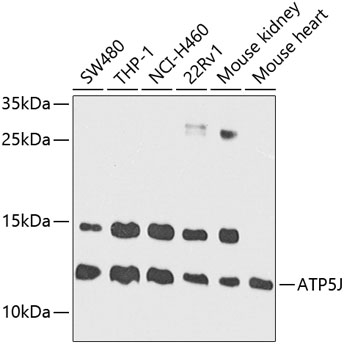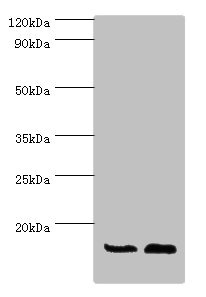ATP5J antibody
GTX110996
ApplicationsImmunoFluorescence, Western Blot, ImmunoCytoChemistry, ImmunoHistoChemistry, ImmunoHistoChemistry Paraffin
Product group Antibodies
TargetATP5PF
Overview
- SupplierGeneTex
- Product NameATP5J antibody
- Delivery Days Customer9
- Application Supplier NoteWB: 1:500-1:3000. ICC/IF: 1:100-1:1000. IHC-P: 1:100-1:1000. *Optimal dilutions/concentrations should be determined by the researcher.Not tested in other applications.
- ApplicationsImmunoFluorescence, Western Blot, ImmunoCytoChemistry, ImmunoHistoChemistry, ImmunoHistoChemistry Paraffin
- CertificationResearch Use Only
- ClonalityPolyclonal
- Concentration1 mg/ml
- ConjugateUnconjugated
- Gene ID522
- Target nameATP5PF
- Target descriptionATP synthase peripheral stalk subunit F6
- Target synonymsATP5, ATP5A, ATP5J, ATPM, CF6, F6, ATP synthase peripheral stalk subunit F6, mitochondrial, ATP synthase subunit h, ATP synthase, H+ transporting, mitochondrial F0 complex, subunit F6, ATP synthase, H+ transporting, mitochondrial Fo complex subunit F6, ATP synthase-coupling factor 6, mitochondrial, ATPase subunit F6, coupling factor 6, mitochondrial ATP synthase, coupling factor 6, mitochondrial ATP synthase, subunit F6, mitochondrial ATPase coupling factor 6, proliferation-inducing protein 36
- HostRabbit
- IsotypeIgG
- Protein IDP18859
- Protein NameATP synthase peripheral stalk subunit F6, mitochondrial
- Scientific DescriptionMitochondrial ATP synthase catalyzes ATP synthesis, utilizing an electrochemical gradient of protons across the inner membrane during oxidative phosphorylation. It is composed of two linked multi-subunit complexes: the soluble catalytic core, F1, and the membrane-spanning component, F0, which comprises the proton channel. The F1 complex consists of 5 different subunits (alpha, beta, gamma, delta, and epsilon) assembled in a ratio of 3 alpha, 3 beta, and a single representative of the other 3. The F0 seems to have nine subunits (a, b, c, d, e, f, g, F6 and 8). This gene encodes the F6 subunit of the F0 complex, required for F1 and F0 interactions. Alternatively spliced transcript variants encoding different isoforms have been identified for this gene. [provided by RefSeq]
- Storage Instruction-20°C or -80°C,2°C to 8°C
- UNSPSC12352203





